A
Auto Express
Guest
Ever since Kia arrived in the UK in 1991, the marque has built a reputation for great-value cars that are easy to own. There's little in the Korean company's line-up to set the enthusiast's pulse racing, but for anybody who just wants affordable, reliable and practical transport, Kia is one of the go-to brands.
Take the Venga, for example, which sums up this no-nonsense approach. This high-roofed supermini puts the emphasis on practicality with low running costs, while dependability is another major draw. With some of the most reliable cars on the road, Kia's seven-year warranty is among the most generous – not that you're likely to need it.
Buy a later Kia Venga and it'll still come with a longer warranty than many new cars, which is perfect if you value peace of mind and low running costs above driving thrills.
Models covered
The Venga arrived in February 2010. Buyers could choose between 89bhp 1.4-litre or 124bhp 1.6-litre petrol engines, or there was an 89bhp 1.4-litre CRDi diesel unit. Whereas the 1.4-litre power plants came only with a five-speed manual gearbox, the bigger petrol engine was available only in four-speed automatic form. The Venga came as a five-door hatchback only, while buyers could choose between three trim levels, badged simply as 1, 2 or 3.
A range refresh in December 2011 led to the introduction of a 1.6-litre CRDi option, standard stop/start for most models (dubbed ISG by Kia), and two new trim levels: 1 Air and 3 Sat-Nav. At the same time, a six-speed manual gearbox became an option for the 1.6-litre petrol engine. Unusually, there were no further developments until the Venga was axed more than seven years later.
If ultimate economy is your priority go for a diesel, but there’s no auto option and you’ll pay less to secure an equivalent petrol-engined Venga, which should still be reasonably economical in manual form. The 1.4-litre CRDi isn’t that flexible and it’s quite coarse too; the 1.6-litre CRDi is a much better engine. Only the 1.6-litre petrol is offered with an automatic gearbox, but this four-speed transmission isn’t very slick.
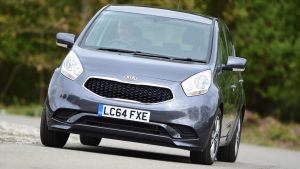
image
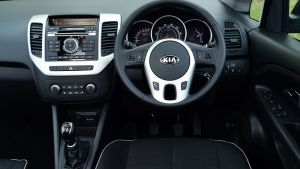
image
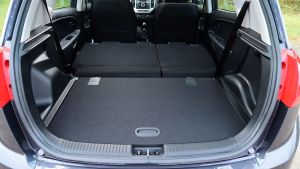
image
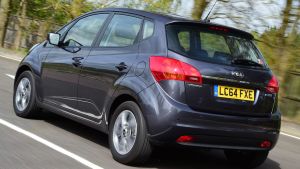
image
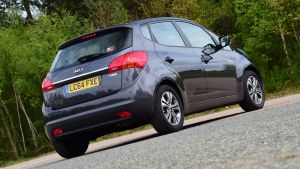
image
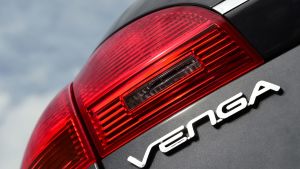
image

image

image

image
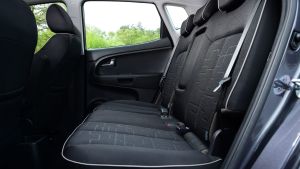
image
No Venga is spartan; entry-level cars have remote central locking, ESP, electric front windows, CD/tuner and USB, but you’ll need to buy a 1 Air (offered from December 2011) if you want air-con. Alloy wheels and a multifunction steering wheel are included with 2 trim, while range-topping 3 adds climate control, privacy glass, powered rear windows and a panoramic sunroof, plus navigation if you buy a 3 Sat-Nav.
The Hyundai ix20 is closely related to the Kia, which is why it comes with the same engine choices and a similar model range, but there are far fewer used ix20s to choose from on the used market. Perhaps the most capable rival is the Honda Jazz, which is incredibly versatile and reliable, but prices tend to be high and the model range is narrow (with no diesel option), although the Mk2 did come in hybrid form.
The Vauxhall Meriva was more expensive than the Venga when new, but savage depreciation means it can make a great used buy, and it's very practical as well as plentiful. The Nissan Note looks neat and is reliable, plus there are plenty to choose from on the used market.
Engines
The 1.4-litre CRDi can suffer from throttle response and hesitation problems, especially if run on cheap fuel.
Rattles
Dashboard rattles are common, especially when it's cold. Things quieten down as the weather warms up.
Brake discs
The front and rear brake discs can wear quickly; some have had to be replaced in under 20,000 miles.
Spare wheel
Kia supplied either a space saver spare wheel or a mobility kit, but a full-sized spare will fit in the well
The dash is clearly laid out and the materials are of a decent quality, but since the Venga arrived, Kia has made big strides with its interiors. Where the Venga really scores is with its cabin space, because despite its compact proportions there’s plenty of space for four adults or five children. A split-level boot aids versatility, along with sliding rear seats. The boot holds at least 440 litres, which expands to an impressive 1,253 litres with the seats folded.

image

image

image

image

image

image

image

image

image

image
Check out the latest used prices for the Kia Venga on our sister site Buyacar.
Buy a petrol-engined Venga and you'll have to get it serviced every 12 months or 12,000 miles; the diesel interval is annually or every 20,000 miles. Each of the first seven services are priced differently; for petrol-engined cars they cost £119-£289, while for diesels they're £59-£319.
Once a Venga is out of warranty, Kia dealers offer a £129 oil and filter change, but many owners buy a service plan which is transferable when the car is sold on; you can pin down the cost at www.kia.com/uk/owners/service-your-kia. Because all Venga engines are chain driven there are no cam belts to replace, but you will need to renew the coolant every 10 years or 120,000 miles; this is included in the service cost. As well as this the brake fluid must be renewed every two years, but once again, the cost of this is already built into the service price.
Despite the Venga being launched more than a decade ago, Kia hasn't issued any recalls for it so far, which is pretty impressive for such an established model. Even more reassuringly, there's a good chance that Kia won't issue any recalls in the future as the company has a good record in this regard. Across all of its model ranges since Kia arrived in the UK in 1991, the brand has issued just 39 recalls, which is impressive considering that covers a three-decade period, with the company having sold several dozen models in that time.
It's likely that Kia has issued several TSBs (Technical Service Bulletins) for the Venga, but these aren't in the public domain as they're not usually safety related. They're issued to dealers only and they can cover an array of common glitches which can be dealt with when the car is serviced.
The Venga notched up a 45th place in our 2018 Driver Power new car survey, which is an impressive result for a car at the end of its (unusually long) lifespan. This achievement was backed up by a 47th place in our 2019 Driver Power used car poll, which once again was a very respectable showing, with Venga owners loving the car's spacious cabin and boot, dashboard layout and refinement – but not the poor fuel economy or driving experience.
When it was launched in 2010, the Kia Venga scooped our Best Supermini-MPV and at the time we said: “The Venga is a refreshingly honest machine that doesn't rely on gimmicks or high-profile gadgets for its appeal. Instead, it simply provides lots of cabin and load space in a handsome package that’s also attractively priced and good to drive.” A decade on all those things still apply, but the prices are now much lower, to make the Venga even more attractive. With owners awarding the Venga an average of four stars out of five on CarBuyer.co.uk, and with Kia coming second in the 2020 Brands survey, out of 30 entries and beaten only by Lexus, you just know that the Venga is a safe place to put your money.
Continue reading...
Take the Venga, for example, which sums up this no-nonsense approach. This high-roofed supermini puts the emphasis on practicality with low running costs, while dependability is another major draw. With some of the most reliable cars on the road, Kia's seven-year warranty is among the most generous – not that you're likely to need it.
Buy a later Kia Venga and it'll still come with a longer warranty than many new cars, which is perfect if you value peace of mind and low running costs above driving thrills.
Models covered
- Kia Venga (2010-2019) – Looking for a supermini with space? A Kia Venga offers just that.
History
The Venga arrived in February 2010. Buyers could choose between 89bhp 1.4-litre or 124bhp 1.6-litre petrol engines, or there was an 89bhp 1.4-litre CRDi diesel unit. Whereas the 1.4-litre power plants came only with a five-speed manual gearbox, the bigger petrol engine was available only in four-speed automatic form. The Venga came as a five-door hatchback only, while buyers could choose between three trim levels, badged simply as 1, 2 or 3.
A range refresh in December 2011 led to the introduction of a 1.6-litre CRDi option, standard stop/start for most models (dubbed ISG by Kia), and two new trim levels: 1 Air and 3 Sat-Nav. At the same time, a six-speed manual gearbox became an option for the 1.6-litre petrol engine. Unusually, there were no further developments until the Venga was axed more than seven years later.
Which one should I buy?
If ultimate economy is your priority go for a diesel, but there’s no auto option and you’ll pay less to secure an equivalent petrol-engined Venga, which should still be reasonably economical in manual form. The 1.4-litre CRDi isn’t that flexible and it’s quite coarse too; the 1.6-litre CRDi is a much better engine. Only the 1.6-litre petrol is offered with an automatic gearbox, but this four-speed transmission isn’t very slick.

image

image

image

image

image

image

image

image

image

image
No Venga is spartan; entry-level cars have remote central locking, ESP, electric front windows, CD/tuner and USB, but you’ll need to buy a 1 Air (offered from December 2011) if you want air-con. Alloy wheels and a multifunction steering wheel are included with 2 trim, while range-topping 3 adds climate control, privacy glass, powered rear windows and a panoramic sunroof, plus navigation if you buy a 3 Sat-Nav.
Alternatives to the Kia Venga
The Hyundai ix20 is closely related to the Kia, which is why it comes with the same engine choices and a similar model range, but there are far fewer used ix20s to choose from on the used market. Perhaps the most capable rival is the Honda Jazz, which is incredibly versatile and reliable, but prices tend to be high and the model range is narrow (with no diesel option), although the Mk2 did come in hybrid form.
The Vauxhall Meriva was more expensive than the Venga when new, but savage depreciation means it can make a great used buy, and it's very practical as well as plentiful. The Nissan Note looks neat and is reliable, plus there are plenty to choose from on the used market.
What to look for
Engines
The 1.4-litre CRDi can suffer from throttle response and hesitation problems, especially if run on cheap fuel.
Rattles
Dashboard rattles are common, especially when it's cold. Things quieten down as the weather warms up.
Brake discs
The front and rear brake discs can wear quickly; some have had to be replaced in under 20,000 miles.
Spare wheel
Kia supplied either a space saver spare wheel or a mobility kit, but a full-sized spare will fit in the well
Interior
The dash is clearly laid out and the materials are of a decent quality, but since the Venga arrived, Kia has made big strides with its interiors. Where the Venga really scores is with its cabin space, because despite its compact proportions there’s plenty of space for four adults or five children. A split-level boot aids versatility, along with sliding rear seats. The boot holds at least 440 litres, which expands to an impressive 1,253 litres with the seats folded.

image

image

image

image

image

image

image

image

image

image
Prices
Check out the latest used prices for the Kia Venga on our sister site Buyacar.
Running costs
Buy a petrol-engined Venga and you'll have to get it serviced every 12 months or 12,000 miles; the diesel interval is annually or every 20,000 miles. Each of the first seven services are priced differently; for petrol-engined cars they cost £119-£289, while for diesels they're £59-£319.
Once a Venga is out of warranty, Kia dealers offer a £129 oil and filter change, but many owners buy a service plan which is transferable when the car is sold on; you can pin down the cost at www.kia.com/uk/owners/service-your-kia. Because all Venga engines are chain driven there are no cam belts to replace, but you will need to renew the coolant every 10 years or 120,000 miles; this is included in the service cost. As well as this the brake fluid must be renewed every two years, but once again, the cost of this is already built into the service price.
Recalls
Despite the Venga being launched more than a decade ago, Kia hasn't issued any recalls for it so far, which is pretty impressive for such an established model. Even more reassuringly, there's a good chance that Kia won't issue any recalls in the future as the company has a good record in this regard. Across all of its model ranges since Kia arrived in the UK in 1991, the brand has issued just 39 recalls, which is impressive considering that covers a three-decade period, with the company having sold several dozen models in that time.
It's likely that Kia has issued several TSBs (Technical Service Bulletins) for the Venga, but these aren't in the public domain as they're not usually safety related. They're issued to dealers only and they can cover an array of common glitches which can be dealt with when the car is serviced.
Driver Power owner satisfaction
The Venga notched up a 45th place in our 2018 Driver Power new car survey, which is an impressive result for a car at the end of its (unusually long) lifespan. This achievement was backed up by a 47th place in our 2019 Driver Power used car poll, which once again was a very respectable showing, with Venga owners loving the car's spacious cabin and boot, dashboard layout and refinement – but not the poor fuel economy or driving experience.
Verdict
When it was launched in 2010, the Kia Venga scooped our Best Supermini-MPV and at the time we said: “The Venga is a refreshingly honest machine that doesn't rely on gimmicks or high-profile gadgets for its appeal. Instead, it simply provides lots of cabin and load space in a handsome package that’s also attractively priced and good to drive.” A decade on all those things still apply, but the prices are now much lower, to make the Venga even more attractive. With owners awarding the Venga an average of four stars out of five on CarBuyer.co.uk, and with Kia coming second in the 2020 Brands survey, out of 30 entries and beaten only by Lexus, you just know that the Venga is a safe place to put your money.
Continue reading...
